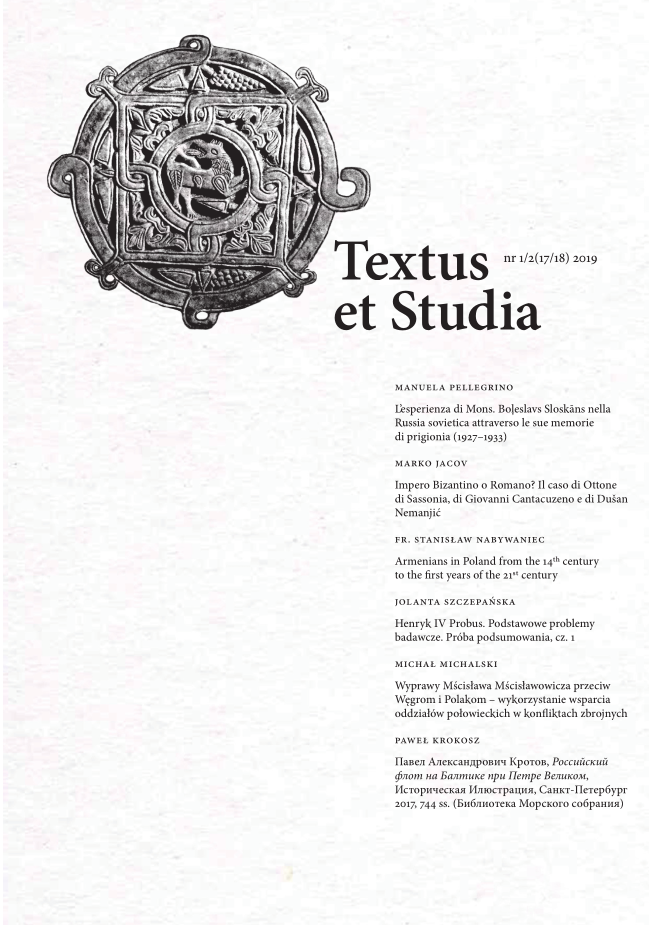Armenians in Poland from the 14th century to the first years of the 21st century
DOI:
https://doi.org/10.15633/tes.05103Keywords:
Armenians, Armenian colonies, Catholic Archbishop of Lwow of the Armenian rite, Eastern trade, Polish Kingdom, Polish Republic, Poland, Red RussiaAbstract
The first groups of Armenians arrived in Red Ruthenia, Podolia, and Kyiv Ruthenia as early as in the 11th century as part of the first wave of exiles before the Seljuk invasion. At the same time the first Armenian settlements in these Polish lands were established. However, a significant development tendency of the Armenian settlement can only be mentioned concerning the reign of Casimir the Great, who also contributed to the raise of the Armenian church in Lviv to the rank of a cathedral. The greatest development of the Armenian settlement in the Polish-Lithuanian Commonwealth took place in the 16th and 17th centuries. At the end of the 17th century, Armenian settlements stretched along the entire south-eastern border of the Republic of Poland. The Armenian colonies in the former Polish-Lithuanian Commonwealth played an important role in the organization of eastern trade. A trade route connecting the East with the West ran through the territory of the Republic of Poland. Apart from economic activity, Armenians played a significant role in the field of diplomacy. All Armenian colonies in the territory of the Republic of Poland enjoyed autonomy. The outbreak of the war in 1939 meant that Poles and Armenians shared the tragic fate. World War II dispersed the Polish Armenians. Some of them – mainly Armenians from the city of Kuty and its surroundings – were murdered in 1943–1944 by the Ukrainians, with the approval of the Germans. Others were taken to Soviet camps or sent to Central Asia. Few Armenians remained in Lviv. Polish Armenians who survived lived in postwar Poland. After the political transformation that took place in Poland and other countries of Central and Eastern Europe, new emigrants from Armenia come to Poland. According to the 2002 national population and housing census, 262 citizens of the Republic of Poland declared themselves as Armenians.
References
Balzer O., Statut ormiański w zatwierdzeniu Zygmunta I z roku 1519, Lwow 1910.
Barącz S., Rys dziejów ormiańskich, Kraków 1869.
Bardach J., Ormianie na ziemiach dawnej polskich, “Kwartalnik Historyczny” 1983, nr 90, pp. 109–118.
Biedrońska-Słotowa B., Ormianie polscy odrębność i asymilacja, Kraków 1999.
Bohosiewicz A., Powojenna historia Ormian polskich, “Horyzonty Wiary”
–1999, nr 9–10, http://www.bohosiewicz.ip.pl/Powojenna.
html [accessed: 7.05.2019].
Centro Studi Immigrazione, Le migrazioni interne in Europa (Centro
Italiano di Formazione Europea), http://www.cestim.org/dossier_
migrazioni/parte_2/interne.htm [accessed: 7.05.2019].
Chowaniec C., Ormianie w Stanisławowie w XVII i XVIII wieku, Stanisławów 1928.
Daszkewycz J., Likwidacija wirmeno-kaatołyćkoji Cerkwy w Hałyczynie, Lwiw 1998.
Gołębiowski K., Ormianie w Polsce, http://www1.gazeta.pl/swiat/1,34296,
html [accessed: 21.03.2005].
Gromnicki T., Ormianie w Polsce [in:] Encyklopedia Kościelna, t. 17, M. Nowodworski (red.), Warszawa 1891.
http://www.lwow.home.pl/orm.html [accessed: 7.05.2019].
http://www.mswia.gov.pl/mn_narod_ormianie.html [accessed: 21.03.2005].
Korwin L., Ormiańskie rody szlacheckie w Polsce, Kraków 1934.
Lewicki T., O Ormianach zamojskich, “Kwartalnik Historyczny” 1966,
nr 73, pp. 407–411.
Mak A., Wierni Polsce od 800 lat. Ormianie, http://www.opoka.org.pl/
biblioteka/Z/ZD/ormianie.html [accessed: 7.05.2019].
Mańkowski T., Orient w Polskiej kulturze artystycznej, Wrocław–Kraków 1959.
Nabywaniec S., Armeni-Cattolici in Polonia prima e dopo il 1989, “Citta di Vita” 2007, no. 6, pp. 593–596.
Oganiesian M., Autonomia Ormiańska w Rzeczpospolitej w XVI–XVII wieku [in:] Studia z dziejów kontaktów polsko-ormiańskich, M. Zakrzewska-Dubasowa (red.), Lublin 1983, pp. 68–89.
Okraska R., Ormianie polscy, “Zakorzenienie” 2000, nr 6(8), http://www.
zakorzenienie.most.org.pl/za8/04.htm [accessed: 7.05.2019].
Petrowicz G., La Chiesa Armena in Polonia e nei paesi limitori, part. 3: 1686–1954, Roma 1988.
Pisowicz A., Sześćsetpięćdziesiąt lat Ormian polskich, “Cracovia-Leopolis” 1998, nr 15, pp. 13–16.
Podhorecki L., Chocim 1621, Warszawa 1988.
Quirini-Popławska D., Polska azylem europejskich emigrantów na przełomie wieków średnich i nowożytnych, “Odrodzenie i Reformacja w Polsce” 1993, nr 23, pp. 35–46.
Stopka K., Ormianie w Polsce dawnej i dzisiejszej, Kraków 2000.
Suchanik J., Ormianie w Polsce, “Rocznik Wschodni” 2004, nr 10–11, pp. 11–22.
Tabińska-Juhasz D., Kresowi Ormianie, http://www.lwow.home.pl/semper/kresowi.html [accessed: 7.05.2019].
Tyszka M., Diecezje Kościoła ormiańskokatolickiego u progu trzeciego tysiąclecia, “Biuletyn OTK” 2002, nr 28–29, pp. 25–26.
Woźniak K.A., Ormianie polscy, http://www.bohosiewicz.ip.pl/text15.htm [accessed: 7.05.2019].
Zakrzewska-Dubasowa M., Historia Armenii, Wrocław–Kraków–Gdańsk 1977.
Zaleski T., Ks. Prałat Leon Isakowicz − proboszcz ormiański i kustosz sanktuarium w Stanisławowie. Zarys biograficzny, “Biuletyn OTK” 2001, nr 24–25, pp. 14–18.
Downloads
Published
Issue
Section
License
Copyright (c) 2021 Stanisław Nabywaniec

This work is licensed under a Creative Commons Attribution-NonCommercial-NoDerivatives 3.0 Unported License.
Authors who publish with this journal agree to the following terms:
- Authors retain the copyright and full publishing rights without restrictions, and grant the journal right of first publication with the work simultaneously licensed under a Creative Commons Attribution 4.0 International License that allows others to share the work with an acknowledgement of the work's authorship and initial publication in this journal.
- Authors are able to enter into separate, additional contractual arrangements for the non-exclusive distribution of the journal's published version of the work (e.g., post it to an institutional repository or publish it in a book), with an acknowledgement of its initial publication in this journal.
- Authors are permitted and encouraged to post their work online (e.g., in institutional repositories or on their website) prior to and during the submission process, as it can lead to productive exchanges, as well as earlier and greater citation of published work (See The Effect of Open Access).

